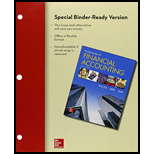
Requirement 1 (a)
The amount of inventory using FIFO.
Requirement 1 (a)
Explanation of Solution
Calculate the amount of inventory:
Requirement 1 (b)
The amount of total assets using FIFO.
Requirement 1 (b)
Explanation of Solution
Calculate the amount of total assets:
Requirement 1 (c)
The amount of total liabilities and stockholders’ equity using FIFO.
Requirement 1 (c)
Explanation of Solution
Calculate the amount of total liabilities and
Requirement 1 (d)
The amount of stockholders’ equity using FIFO.
Requirement 1 (d)
Explanation of Solution
Calculate the amount of stockholders’ equity:
Requirement 2 (a)
The amount of inventory using weighted average.
Requirement 2 (a)
Explanation of Solution
Calculate the amount of inventory using weighted average:
Step 1: Calculate the weighted average cost per unit.
Step 2: Calculate the amount of inventory using weighted average.
Requirement 1 (b)
The amount of total assets using weighted average.
Requirement 1 (b)
Explanation of Solution
Calculate the amount of total assets using weighted average:
Requirement 1 (c)
The amount of total liabilities and stockholders’ equity using weighted average.
Requirement 1 (c)
Explanation of Solution
Calculate the amount of total liabilities and stockholders’ equity:
Requirement 1 (d)
The amount of stockholders’ equity using weighted average.
Requirement 1 (d)
Explanation of Solution
Calculate the amount of stockholders’ equity:
Requirement 3 (a)
The amount of inventory using LIFO.
Requirement 3 (a)
Explanation of Solution
Calculate the amount of inventory:
Requirement 3 (b)
The amount of total assets using LIFO.
Requirement 3 (b)
Explanation of Solution
Calculate the amount of total assets:
Requirement 3 (c)
The amount of total liabilities and stockholders’ equity using LIFO.
Requirement 3 (c)
Explanation of Solution
Calculate the amount of total liabilities and stockholders’ equity:
Requirement 3 (d)
The amount of stockholders’ equity using LIFO.
Requirement 3 (d)
Explanation of Solution
Calculate the amount of stockholders’ equity:
Requirement 4 (i)
The current ratio using FIFO.
Requirement 4 (i)
Explanation of Solution
Calculate the current ratio:
Requirement 4 (ii)
The current ratio using weighted average.
Requirement 4 (ii)
Explanation of Solution
Calculate the current ratio:
Requirement 4 (iii)
The current ratio using LIFO.
Requirement 4 (iii)
Explanation of Solution
Calculate the current ratio:
The ratios are differing due to the inventory costing method assigned. Under FIFO method inventory is computed using the higher last–in costs, however, LIFO is using the lower first–in costs, and weighted average being an average of all costs.
Want to see more full solutions like this?
Chapter 7 Solutions
Loose-leaf for Fundamentals of Financial Accounting with Connect
- Which of the following is an intangible asset? A) InventoryB) CopyrightC) EquipmentD) Accounts Receivableno aiarrow_forwardWhich of the following is an intangible asset? A) InventoryB) CopyrightC) EquipmentD) Accounts Receivablearrow_forwardWhat does a ledger account represent? A) A detailed record of all business transactionsB) A summary of trial balancesC) An individual record for each accountD) The final balance of a financial statement Need help!arrow_forward
- What is the primary purpose of accounting? A) To generate tax revenueB) To record, summarize, and report financial transactionsC) To determine the market value of assetsD) To manage payrollarrow_forwardWhat are the three main financial statements in accounting?arrow_forwardCan you solve this general accounting question with accurate accounting calculations?arrow_forward
 College Accounting, Chapters 1-27AccountingISBN:9781337794756Author:HEINTZ, James A.Publisher:Cengage Learning,Principles of Accounting Volume 2AccountingISBN:9781947172609Author:OpenStaxPublisher:OpenStax College
College Accounting, Chapters 1-27AccountingISBN:9781337794756Author:HEINTZ, James A.Publisher:Cengage Learning,Principles of Accounting Volume 2AccountingISBN:9781947172609Author:OpenStaxPublisher:OpenStax College Accounting Information SystemsAccountingISBN:9781337619202Author:Hall, James A.Publisher:Cengage Learning,
Accounting Information SystemsAccountingISBN:9781337619202Author:Hall, James A.Publisher:Cengage Learning,- Principles of Accounting Volume 1AccountingISBN:9781947172685Author:OpenStaxPublisher:OpenStax College
 College Accounting (Book Only): A Career ApproachAccountingISBN:9781337280570Author:Scott, Cathy J.Publisher:South-Western College Pub
College Accounting (Book Only): A Career ApproachAccountingISBN:9781337280570Author:Scott, Cathy J.Publisher:South-Western College Pub Auditing: A Risk Based-Approach (MindTap Course L...AccountingISBN:9781337619455Author:Karla M Johnstone, Audrey A. Gramling, Larry E. RittenbergPublisher:Cengage Learning
Auditing: A Risk Based-Approach (MindTap Course L...AccountingISBN:9781337619455Author:Karla M Johnstone, Audrey A. Gramling, Larry E. RittenbergPublisher:Cengage Learning





